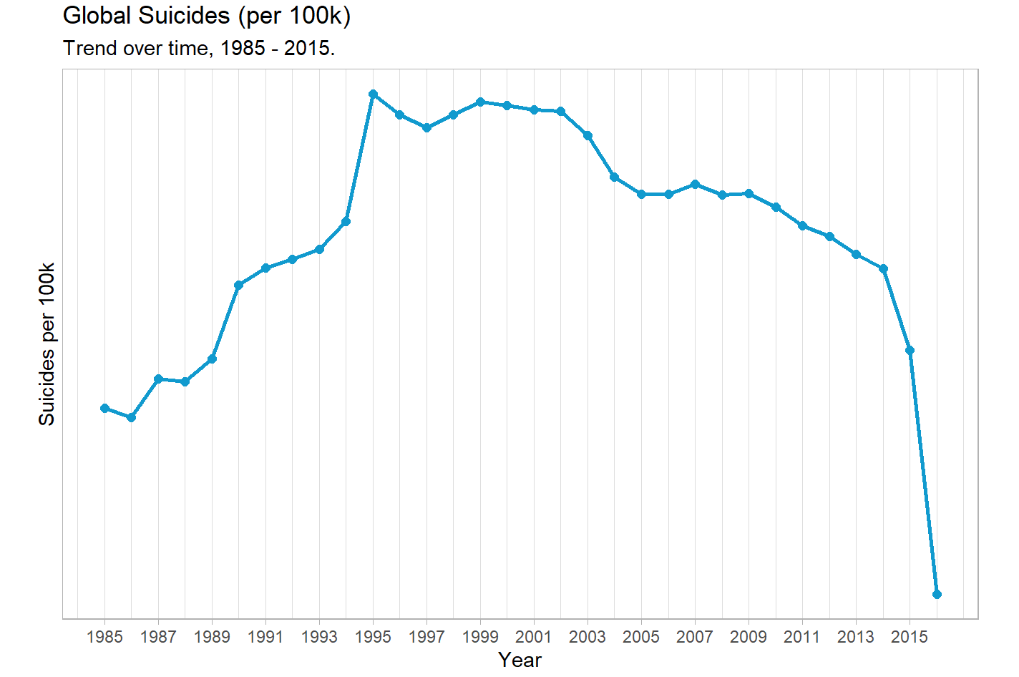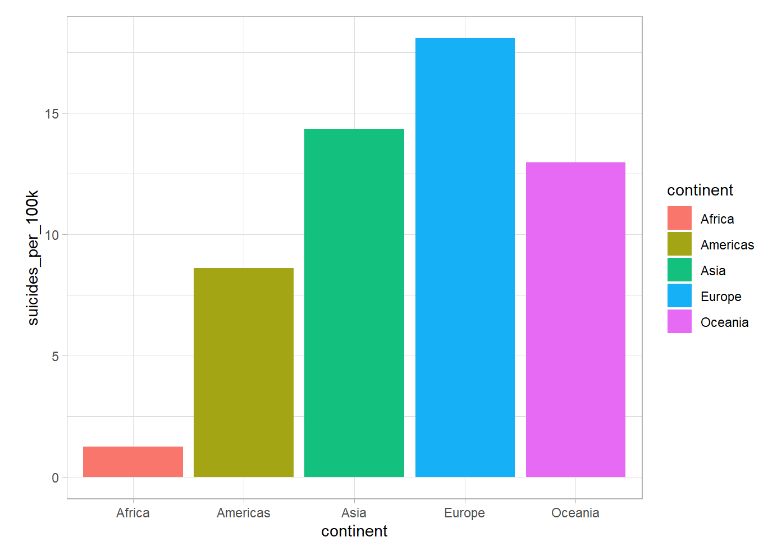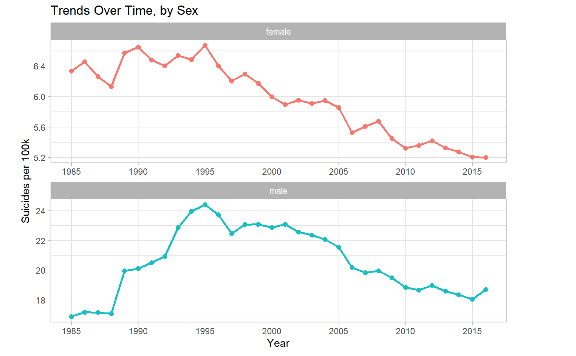Introduction
People die for a variety of reasons, brought upon both by accident and specific conditions. While inevitable, death presents significant interest for research, especially in its connection to other factors. The causes of death in a demographic or populace can tell researchers much about the surrounding political, cultural, social, and economic conditions. In this vein, one of the most “telling” types of death is suicide. Each year, the world loses considerable portion of its population to suicide. However, the specific demographics more likely to take their own lives are different depending on their location, income, living conditions, and many other factors. For example, some studies show that suicide patterns within East Asia and the West vary both their prevalence and gender composition (Snowdon, 2018). Suicide mortality, too, is a metric that is often changing depending on outside circumstances, prompting research (Alothman & Fogarty, 2020). Analyzing disparities between suicide rates has the potential to point at emergent systematic problems, along with the currently existing historical issues. The present study aims to examine the differences in rates of suicide across countries, using age, generation, sex, and GDP as points of comparison. In particular, the work attempts to determined the existence of differences among male and female suicide rates, accounting for the effects of age (AGE), and generation “Gen”, across countries. Data will be primarily drawn from the World Bank organization, which aggregates statistical data from around the world.
Description of the Data
The World Bank is an organization collecting publicly available data on global development and statistics. The overall purpose of the organization is to improve data availability among the population, making research into both worldwide and local trends more convenient. The World Bank Data Catalogue organizes and presents all of the collected information in an online format. It is important to note, however, that the World Bank assumes no personal accountability for any errors, omissions or discrepancies of data, instead acting as a tool for public access. Datasets from the World Bank can be sorted into a variety of categories, including country, age, sex, number of suicides, GDP, and others. The collected statistics cover a total of 101 countries over a period of time found to be statistically significant. Specific variables, including sex, age, generation, and a specific time period between 1985 and 2016 was considered. Generations X, Z, Silent, GL generation, Boomers and Millenials were included in the analysis.

Analyzing the figure, there are clear trends relating to the prevalence of suicide among populations. As a whole, the number of yearly suicides decreased from 1985 to 2015, however, significant fluctuations of numbers are present. 1995 was a year of an all-time high in suicides around the world. The period between 2015 and 2016 is noted for a sharp drop in suicide rates, which, however, has high probability of being incorrect. Most likely the recorded data for the dataset does not include all of the information regarding suicide rates, affecting the appearance of the graph. Analysis of bar chart regarding mortality by country also reveals interesting patterns of mortality.


Europe surpasses other continents based on suicide rates, followed closely by Asia and Oceania. Comparatively, Africa’s rates of suicide per 100k people are especially low. Additionally, data regarding suicide by sex also displays differences in population. Every year men take their lives twice or even thrice more often than women, peaking in 1995 specifically. While a decrease from the all-time high is evident, the present rates of suicide for men are higher than they were in 1985. Women peak in 1995 as well, with a similar peak in 1990.The subsequent rates of suicide rapidly decrease over the years, going lower than they were at the start of the data collection.
Proposed Analysis
Marginal longitudinal analysis is used to reach population-average conclusions. The present research seeks to examine and compare differences between male and female suicide within different nations, making this approach the most suitable. The analysis is used to showcase differences between populations of interest, namely age, sex and GDP per capita. This method does not account for individual-level differences in data, instead focusing on overarching trends. The Generalized Estimating Equations, or GEE method will be additionally used to create a marginal model for the effects of variables on Suicide Rates. An interaction for two variables of Sex and Years is permitted, meaning that the response trajectory can vary depending on the former. A total of 4 correlation structures will be discussed – independence, exchangeable, AR-1, and unstructured. The first disallows any responses to be correlated, while the second ensures that each pair of responses are correlated equality. AR-1 allows correlations between close variables to be higher, while the unstructured correlation structures gives all correlations the capacity to vary freely.
Analysis Results
GEE model can be analyzed using summary measures and residuals. Applying similar summery measures to the QIC values should produce an appropriate correlation structure. Table shows the recorded range of residuals depending on choices of correlation structure. The independent correlation model shows that lowest QIC values, and a smallest residual min. value. Further examination suggests that the use of an exchangeable structure is justified, having strong values according to the table. Therefore, the study will apply this structure as its main correlation structure.
Conclusions
Data collected and analyzed as a part of this work suggests that there are differences in male and female suicide rates, when accounting specifically for age, GDP and autocorrelation appropriate for this type of data. According to the model, it is expected that male suicide cases outnumber the female ones at a rate of 3 to 1, or even 4 to 1. In the late 90’s especially, the trend can be easily seen within the data. Suicides were at an all-time high in 1995, gradually declining from that point onward. On a global scale, probability of suicides increases with age, where 75+ year-old people have the highest rates of suicide. Distribution of suicides depending on generation varies, with the silent generation having the highest recorded rate of suicide among all others. The majority of aforementioned trends apply to at least 90 countries included in the review, with certain exceptions.
It should be noted, however, that cultural, historical, legislative or religious factors were not accounted for as a part of this work. Socially-different factors may have a large contribution towards suicide prevalence (Abrutyn & Mueller, 2018). Culture, social stigma around suicide, prevalence of religious condemnation of suicide, among other factors, is likely to influence suicide rates. Further analysis of various variables regarding suicidality is needed. Consideration of social, economic, cultural, religious factors as a necessary part of discussing suicide is necessary.
References
Abrutyn, S., & Mueller, A. S. (2018). Toward a cultural-structural theory of suicide: Examining excessive regulation and its discontents. Sociological Theory, 36(1), 48–66.
Alothman, D., & Fogarty, A. (2020). Global differences in geography, religion and other societal factors are associated with sex differences in mortality from suicide: An Ecological Study of 182 countries. Journal of Affective Disorders, 260, 67–72.
Snowdon, J. (2018). Differences between patterns of suicide in East Asia and the west. the importance of sociocultural factors.Asian Journal of Psychiatry, 37, 106–111. Web.